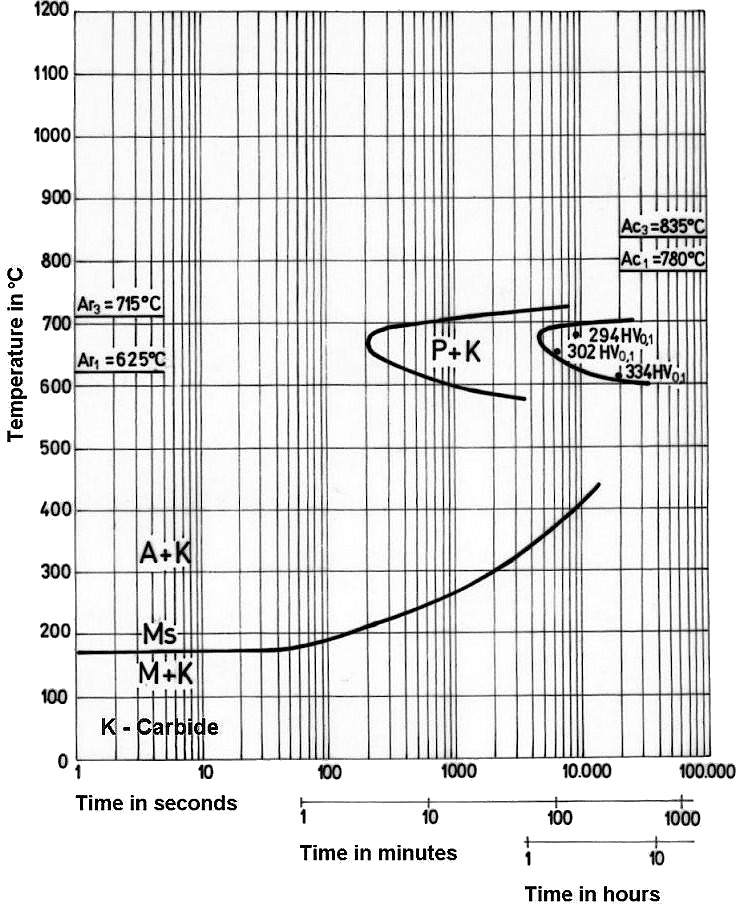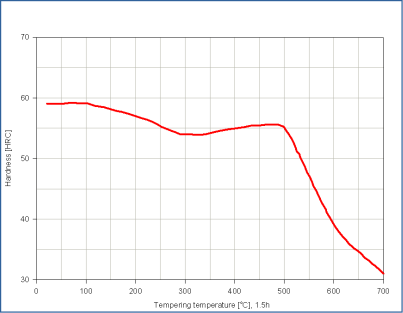
SINOXX 4125 Steel
Designation by Standards
Brand Name | Ravne | Mat. No. | DIN | EN | AISI/SAE |
SINOXX 4125 | PK348 | 1.4125 | - | X105CrMo17 | 440C |
Chemical Composition (in weight %)
C | Si | Mn | Cr | Mo | Ni | V | W | Others |
1.08 | max. 1.0 | max. 1.0 | 17.00 | 0.60 | - | - | - | - |
Description
This is a high carbon martensitic stainless with moderate corrosion resistance good strength and the ability to obtain and keep excellent hardness HRC 60 and wear resistance.
Applications
Ball bearings and races, gage blocks, molds and dies, cutlery, valve components, knives and measuring instruments and other products with highest hardness and wear resistance.
Physical properties (average values) at ambient temperature
Modulus of elasticity [103 x N/mm2]: 200 Density [g/cm3]: 7.67
Thermal conductivity [W/m.K]: 24.2
Electric resistivity [Ohm mm2/m]: 0.60 Specific heat capacity[J/g.K]: 0.46
Coefficient of Linear Thermal Expansion 10-6 oC-1
20-100oC | 20-200oC | 20-300oC | 20-400oC | 20-500oC | 20-600oC | 20-700oC |
9.8 | 10.8 | 11.4 | 11.7 | 12.0 | 12.2 | 12.4 |
Continuous Cooling Transformation (CCT) Diagram

Time-Temperature Transformation (TTT) Diagram

Soft Annealing
Heat to 820-860oC, cool slowly in furnace. This will produce a maximum Brinell hardness of 269.
Hardening
Harden from a temperature of 1000-1050oC followed by oil or quenching. Hardness after quenching is min. 58 HRC.
Tempering
Tempering temperature: See the data bellow.
Tempering Temperature (oC) vs. Hardness (HRC)
100oC | 200oC | 300oC | 400oC | 500oC | 600oC | 600oC |
59 | 57 | 54 | 55 | 55 | 39 | 31 |
Tempering Diagram

Forging
Pre-heat to 760oC, then bring slowly up to 1038-1204oC before proceeding. Do not work this material below 927oC. Cool material slowly after working and once at room temperature, anneal fully.
Machinability
Best machined in the annealed condition. Tough, stringy chips can be best handled by the use of chip breakers. Carbide or ceramic tooling is recommended.
Cold Working
This alloy is considered only slightly cold workable by common practices.
Corrosion Resistance
Resistant to a wide variety of media including fresh water, steam, petroleum products and alcohol. The material is not recommended to be used in annealed condition as it may get rusty. Correct passivation process recommendation to improve the corrosion resistance in quenched and tempered form. HT recommendation to obtain best corrosion resistance. In this case as per the recommendation that is obtained thru low temperature tempering with mirror finished surface. The 440 steel is not recommended to be used in elevated temperature application i.e above 400oC. Corrosion resistance is reduced when used in elevated temperarure condition.
Welding
This alloy is not commonly welded due to its tendency to air harden. If it must be welded, preheat to 260oC and post weld treat at 732- 760oC for 6 hours followed by a slow furnace cooling to avoid cracking. Use similar filler metal.
Forms manufactured: Please see the Dimensional Sales Program.
Disclaimer
The information and data presented herein are typical or average values and are not a guarantee of maximum or minimum values. Applications specifically suggested for material described herein are made solely for the purpose of illustration to enable the reader to
make his own evaluation and are not intended as warranties, either express or implied, of fitness for these or other purposes. There is no representation that the recipient of this literature will receive updated editions as the become available.
Unless otherwise specified, registered trademarks are property of SIJ Metal Ravne company. Copyright 2016 by SIJ Metal Ravne d.o.o. All rights reserved. Contact our Sales Office for more information.